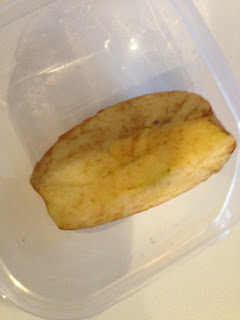I wanted to introduce my kids to the concept of designing and making. I began by giving them a couple of things that I thought would help them complete the task. These included:
- A lid that came off a "city scene" box that my kids had. It had a picture of grass and two lakes. You can use anything to set the scene - you could even cut up some paper to make it look like water, or you could use some tape to make a busy road
- Paddle pop sticks
- Playdough
- Toilet paper rolls
- Tools (I thought the tools would capture their interest - and it did!!)
- Cardboard
- Pencils
- Small cars/trucks
I then set the scene...
This little truck wants to go over the lakes... Look how the truck drives around the lakes - it's taking so much time! Look! It's getting stuck because there is not enough room to move! The truck wants to go across the water - how can we get it across the water?
E: A boat! Or a bridge!
He was right onto it!
Usually when we facilitate a design and make session, the kids are asked to "design" by drawing a plan of what they are going to do before they actually build it. Because this is the first time my kids have done this, I decided to swap it around and get their creative juices flowing first by "doing" then drawing what they did. This is how it went...
The beauty of the design and make process is that the list of things to design and make is endless - building a bridge is just one idea. Maybe you would like to design and make a shelter for a pet? The houses in the story The Three Little Pigs? An obstical course for a younger sibling? An obstical course for a dog? A car? A park?....should I keep going? 😉
At first they were a little lost - they poured all of the paddle pop sticks onto the water and E proudly said that that was their bridge. Rather than take them all off and show them another way, I got the truck and showed them that the truck still couldn't get over the water because all of the paddle pop sticks were moving around and it was too bumpy for the truck.
I asked them to think of another way to build a bridge that wasn't so bumpy and...
Great idea! But the truck finds it really hard to climb up the edges of the bridge. What do we need to help the truck to get up?
Awesome idea!! Paddle pop sticks sloped onto the container and some play dough to hold the "ramp" together. E took it upon himself to test the bridge and check if it was easier to travel up... It was! I love love love everything that happened there - problem solving, making, testing, re-making, retesting, fixing, thinking, questioning... This activity has it all!
Extra challenge for E - can you make another bridge using different materials?
This is what he came up with ...
4 toilet paper rolls with cardboard on top. Initially there was only 3 toilet rolls (N was busy with the 4th toilet roll I had initially put out) so he made me get another one so there was an even amount on both sides!
Pretty creative! And so much fun! I love the look on their faces when they are engaged in these activities!
You might notice that E was the only one doing this experiment. At almost 4 years old this experiment was more suited to E than N who is 2 and a half. Having said that, N came up with his own little experiment - throwing a big blob of play dough through a toilet paper roll and seeing how far the play dough flew through the air and onto the floor... Hours of fun and lots of giggles! It kept him amused for ages! Love that :)
The beauty of the design and make process is that the list of things to design and make is endless - building a bridge is just one idea. Maybe you would like to design and make a shelter for a pet? The houses in the story The Three Little Pigs? An obstical course for a younger sibling? An obstical course for a dog? A car? A park?....should I keep going? 😉











































